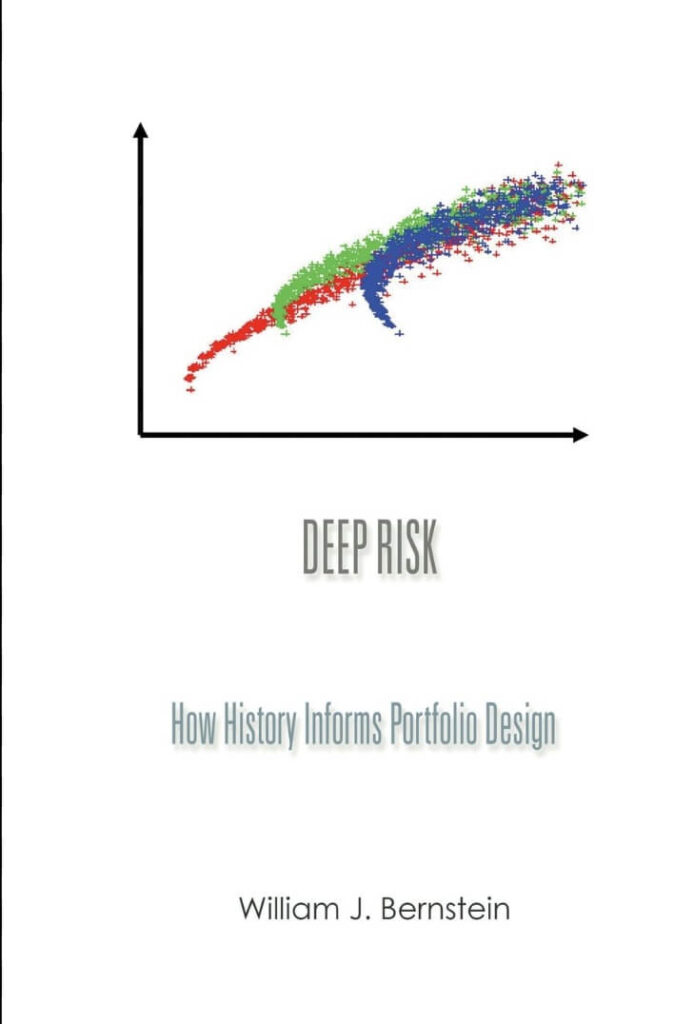When most investors think about risk, they imagine market crashes — days when portfolios plunge, headlines scream, and fear takes over. But in Deep Risk: How History Informs Portfolio Design, William J. Bernstein challenges that view. He argues that what we typically fear — temporary volatility — isn’t the real threat. The real danger lies in something deeper, slower, and far more destructive: the permanent loss of capital over time.
In this compact yet profound book, Bernstein reframes how we define risk. With his signature clarity and historical insight, he explains that volatility is a distraction — the true enemy is what he calls “deep risk.”
💡 Why This Book Is a Game-Changer
Unlike most investing books that focus on short-term fluctuations or asset allocation models, Deep Risk asks a more fundamental question: what risks actually matter over the long term — and how do we defend against them?
Bernstein shows that deep risk is not about your portfolio going down this year. It’s about losing purchasing power forever due to forces like inflation, confiscation, war, or political upheaval. The book is short — just over 60 pages — but its message is lasting.
It’s not a guide to outperforming the market. It’s a guide to surviving it.
🧠 The Core Idea: Not All Risk Is Created Equal
Bernstein distinguishes between two very different types of risk:
⦁ Shallow Risk
Temporary drops in portfolio value due to market volatility. These are scary, but recoverable. Think of the 2008 crash or COVID sell-off — painful, but usually reversed in time.
⦁ Deep Risk
Permanent loss of capital. These are slow-moving threats like:
⦁ Inflation: Erodes purchasing power
⦁ Deflation: Destroys debt-based economies
⦁ Confiscation: Government seizure or excessive taxation
⦁ Devastation: War, natural disaster, or political collapse
Bernstein argues that most investors are overprotecting against shallow risk (market dips), while leaving themselves dangerously exposed to deep risk.
📚 What Makes Deep Risk Unique?
🕰️ History as a Risk Management Tool
Bernstein uses history as his lab. From Weimar Germany to modern Argentina, from the U.S. Civil War to Japanese deflation, he examines how deep risk has destroyed wealth across time and geography — and how investors fared when they were diversified versus concentrated.
🔍 Focused and Concise
At just over 60 pages, this book is refreshingly tight. There’s no filler, no fluff — just distilled insight. It’s a fast read but a slow digest.
🔄 Rethinking Conventional Wisdom
Bernstein challenges the fear of volatility that dominates investing culture. He shows that tolerating volatility may be essential to avoiding deeper, longer-lasting losses — especially from inflation.
🎯 Real-World Relevance
In today’s economic environment — where inflation fears are rising, political risk is global, and asset prices are high — Deep Risk feels especially urgent. It’s a book that reframes:
⦁ What you fear: A 30% dip? Or a 100% loss of purchasing power over 30 years?
⦁ What you hold: Stocks may be volatile, but they protect against inflation better than bonds.
⦁ Where you live: Geographic diversification matters in a world of political instability.
For global investors, retirees, and anyone planning decades into the future, Bernstein offers a new lens: don’t just seek returns — insure against irreversible loss.
✅ Why You Should Read It
It Teaches True Long-Term Thinking
While most books focus on the next quarter or the next correction, Bernstein’s gaze stretches decades. He urges readers to think not just in percentages, but in generations.
It Clears Up Risk Confusion
Most financial media conflates volatility with risk. Bernstein untangles the two and helps readers stop overreacting to short-term noise.
It Makes You a Smarter Global Investor
With historical case studies from across the world, Deep Risk gives you a global framework to think about political and economic safety — and how to protect your wealth across borders.
⚠️ Where It Might Be Challenging
It’s Short — But Dense
Some readers may expect a full-length book. This is more like a long essay, but don’t mistake brevity for lack of depth. Each page is packed with insight, and you’ll likely want to re-read it to fully absorb the ideas.
Limited Step-by-Step Advice
While Bernstein outlines general strategies (e.g., international diversification, owning equities), he doesn’t provide a specific model portfolio or toolset. This is a book for thought, not a plug-and-play investment guide.
More Strategic Than Tactical
You won’t find day-to-day investing tips here. This is a philosophical and strategic text that aims to rewire your understanding of risk.
💬 What Readers and Critics Say
“A paradigm shift in how I understand investing risk.”
“Short, sharp, and unforgettable.”
“The most important 60 pages an investor can read.”
Readers love the book’s clarity, and many describe it as one of Bernstein’s most impactful works — especially when paired with his other writings.
📈 Key Takeaways
⦁ Stocks are volatile, but they defend against inflation better than bonds or cash.
⦁ Diversification across countries and asset classes is a must to guard against confiscation and devastation.
⦁ Don’t just fear market dips — fear losing real purchasing power over time.
⦁ Risk is not what happens in a bad year. It’s what happens over a bad century.
📌 Final Verdict: ★★★★★ (5/5)
Deep Risk is short, sharp, and essential. It’s a different kind of investing book — not about performance, but about survival. Not about upside, but about avoiding irreversible downside.
If you’re ready to stop thinking like a day trader and start thinking like a steward of long-term capital — for yourself, your retirement, or your family’s future — this book will change how you measure risk and reshape how you allocate assets.
In a world obsessed with beating the market, Deep Risk asks the more important question: Can you protect what you’ve earned, and preserve it against history’s worst-case scenarios?
For the thoughtful investor, the answer starts here.




